Context:
This article is based on the news “India’s multidimensional poverty rate down to 11.28% in 2022-23 from 29.17% in 2013-14” which was published in the Indian Express. According to a discussion paper ‘Multidimensional Poverty in India since 2005-06’ released by NITI Aayog, the share of India’s population living in multidimensional poverty is estimated to have fallen to 11.28% in 2022-23 from 29.17% in 2013-14.
| Relevancy for Prelims: NITI Aayog, Multidimensional Poverty Index (MPI), National Family Health Surveys (NFHS), Suresh Tendulkar Committee (2009), World Bank, MGNREGA, and Public Distribution System.
Relevancy for Mains: About Poverty, Evolution of Poverty Estimation in India, Government Multi-Dimensional Approach for Poverty Reduction, Challenges and Way Forward. |
- Poverty Reduction: NITI Aayog estimates a total of 24.82 crore people escaped multidimensional poverty in the last nine years.
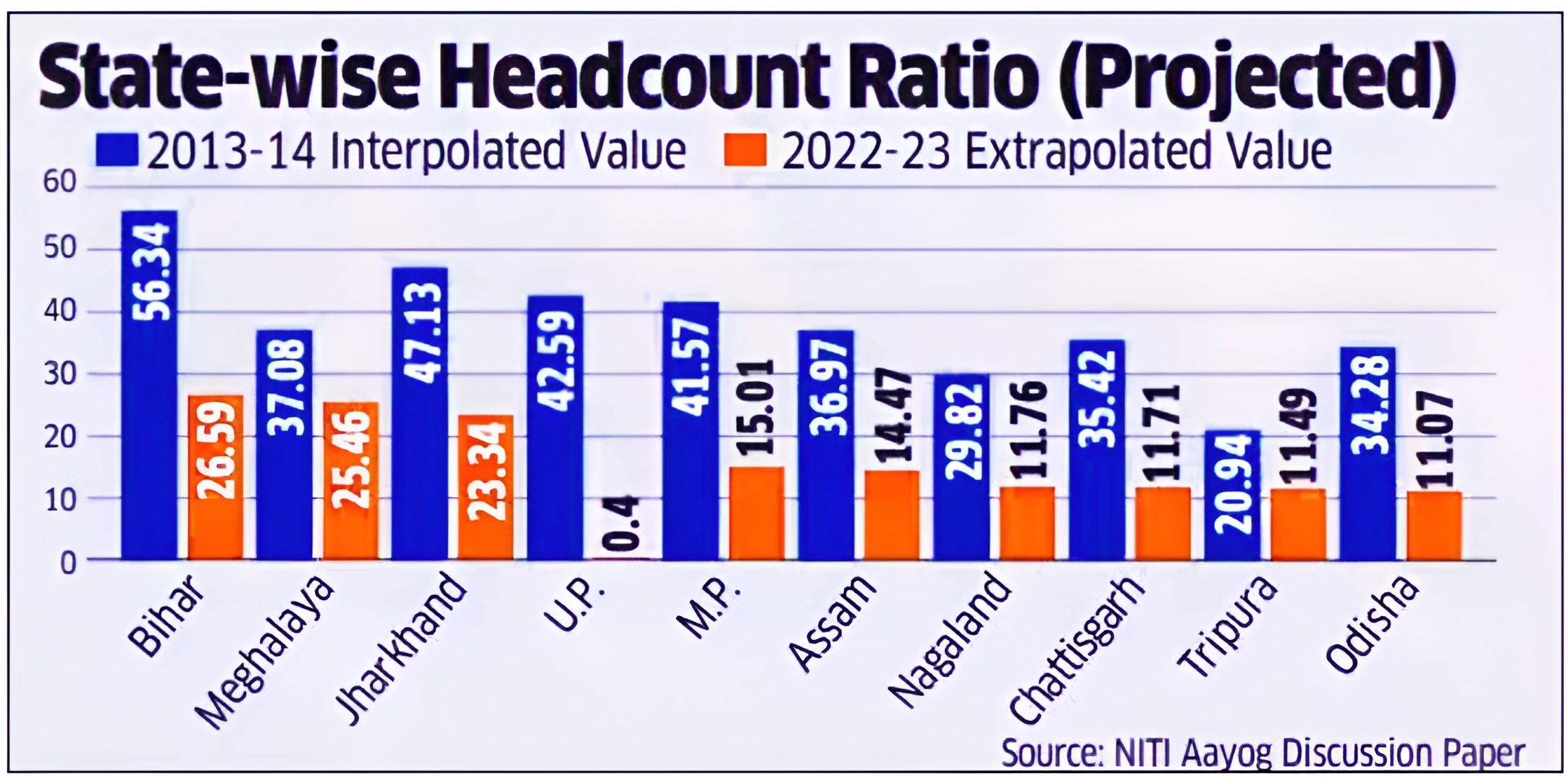 State-wise Estimates: States like Uttar Pradesh, Bihar, Madhya Pradesh, and Rajasthan recorded the sharpest decline in people classified as poor based on the Multidimensional Poverty Index (MPI).
State-wise Estimates: States like Uttar Pradesh, Bihar, Madhya Pradesh, and Rajasthan recorded the sharpest decline in people classified as poor based on the Multidimensional Poverty Index (MPI).
- For instance, Bihar recorded a drop from 56.3 percent share of MPI poor in 2013-14 to 26.59 percent in 2022-23.
- Poverty Headcount Ratio: The pace of decline in poverty headcount ratio was much faster between 2015-16 to 2019-21 (10.66% annual rate of decline) compared to the period 2005-06 to 2015-16 (7.69% annual rate of decline).
- Severity of Deprivation: It measures the average multidimensionally poor person who suffers from deprivation. Deprivation declined slightly between 2015-16 and 2019-21 compared to 2005-06 and 2013-14.
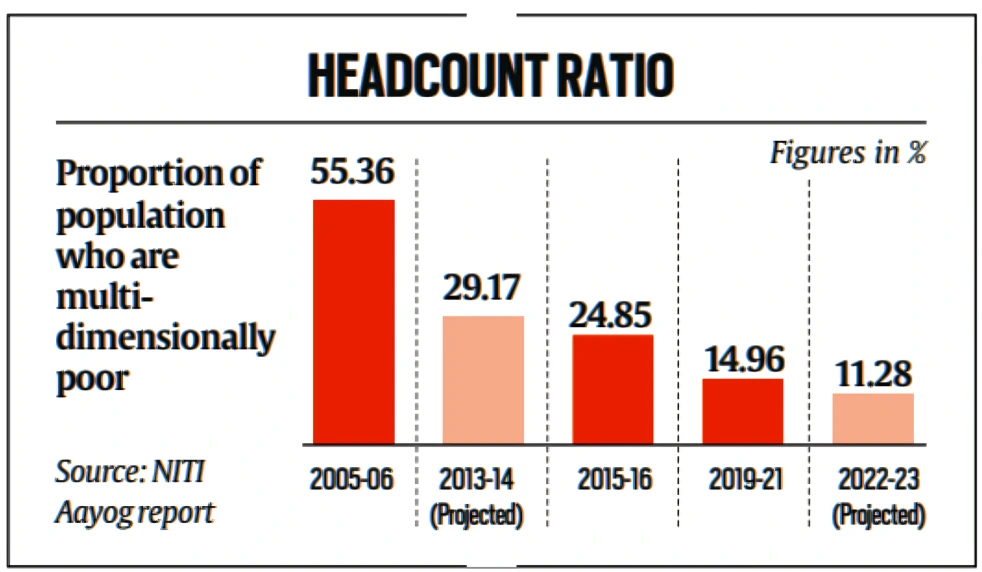 Within the standard of living dimension, the highest levels of deprivation in 2005-06 were found in indicators such as Cooking Fuel (74.40%), Sanitation (70.92%), and Bank Accounts (58.11%).
Within the standard of living dimension, the highest levels of deprivation in 2005-06 were found in indicators such as Cooking Fuel (74.40%), Sanitation (70.92%), and Bank Accounts (58.11%). - The latest estimates show that Cooking Fuel (43.90%) and Housing (41.37%) continue to have the highest deprivation, while indicators like Bank Accounts (3.69%) maintain the lowest deprivation levels based on NFHS-5 (2019-21).
- Data Used: The discussion paper uses previously released MPI data based on National Family Health Surveys (NFHS) conducted in 2015-15 and 2019-21 also uses NFHS-3 data from 2005-06 to understand long-term poverty trends.
- Based on these three NFHS datasets, NITI Aayog estimated the share of MPI poor in the years 2013-14 and 2022-23 with technical inputs from the Oxford Policy and Human Development Initiative (OPHI) and the United Nations Development Programme (UNDP).
Evolution of Poverty Estimation in India
- YK Alagh Committee (1979): It constructed a poverty line for rural and urban areas based on nutritional requirements and related consumption expenditure.
- Lakdawala Committee (1993): It suggested that consumption expenditure should be calculated based on calorie consumption. State-specific poverty lines should be constructed.
- Suresh Tendulkar Committee (2009): The current official measures of poverty in India are based on the Tendulkar poverty line, fixed at a daily expenditure of ₹27.2 in rural areas and ₹33.3 in urban areas is criticized by many for being too low.
- C. Rangarajan Committee (2012-14): The committee raised the cost of living per day to Rs. 32 and Rs. 47 for rural and urban areas, respectively.
|
About Poverty
- Poverty: According to the World Bank, poverty is pronounced deprivation in well-being and comprises many dimensions.
- It includes low incomes and the inability to acquire the basic goods and services necessary for survival with dignity.
- The international poverty line is currently $2.15 per person per day.
- Poverty also encompasses
- Low levels of health and education.
- Poor access to clean water and sanitation.
- Inadequate physical security.
- Lack of voice.
- Insufficient capacity.
- Opportunity to better one’s life.
About Multidimensional Poverty Index
- Multidimensional Poverty Measure: It seeks to understand poverty beyond monetary deprivations by including access to education and basic infrastructure and the monetary headcount ratio at the $2.15 international poverty line.
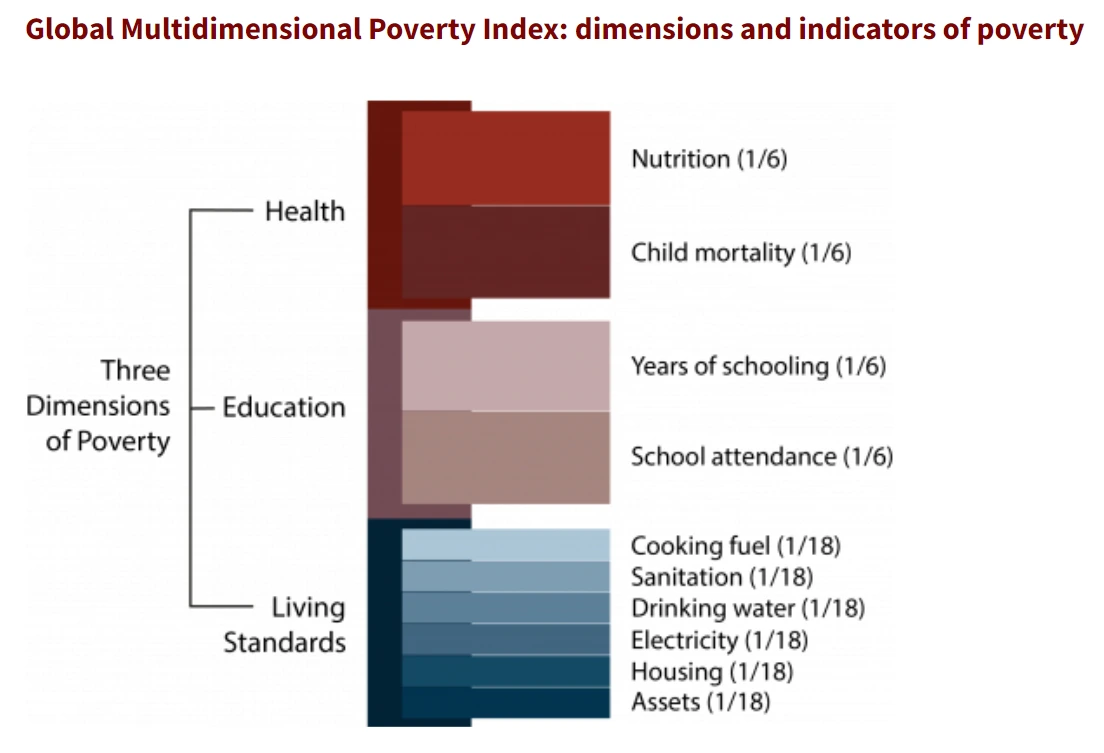 Global Multidimensional Poverty Index (MPI): It is an international measure of acute multidimensional poverty that complements traditional monetary poverty measures by capturing the acute deprivations in health, education, and living standards that a person faces simultaneously.
Global Multidimensional Poverty Index (MPI): It is an international measure of acute multidimensional poverty that complements traditional monetary poverty measures by capturing the acute deprivations in health, education, and living standards that a person faces simultaneously.- NITI Aayog’s National Multidimensional Poverty Index: It measures poverty using twelve indicators and seeks to measure poverty more holistically than solely relying on income levels to assess deprivation.
- Methodology: MPI’s global methodology is based on the robust Alkire and Foster (AF) method.
- Poverty in India: According to the World Bank, the poverty headcount ratio at US $2.15 a day (2017 PPP) decreased from 18.73% in 2015 to 11.9% in 2021 in India.
- With the ongoing rate of decline in India’s Multidimensional Poverty, it is expected to reach a single-digit level of poverty by the year 2024-25.
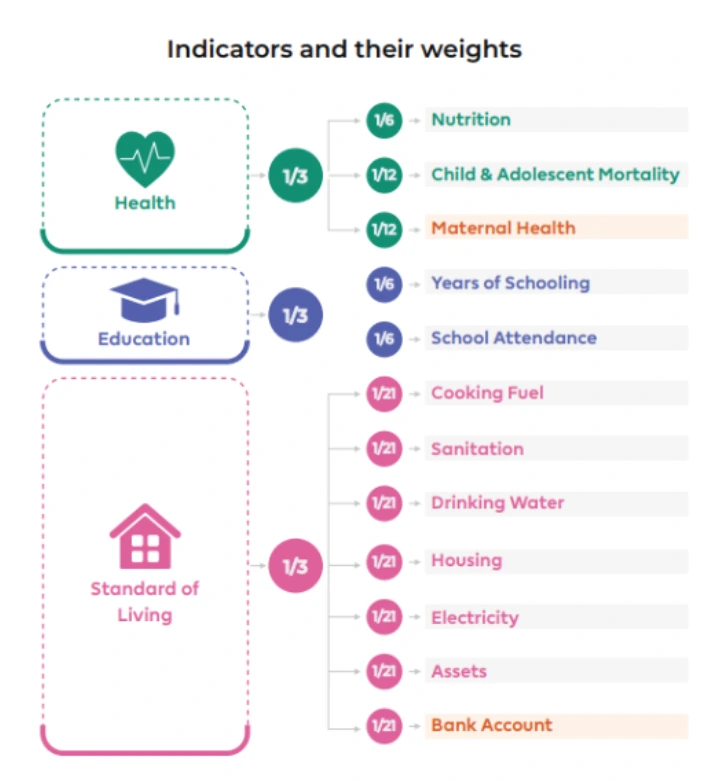 Multidimensional Poverty Index (MP) is considered a better measure to estimate poverty than conventional measures.
Multidimensional Poverty Index (MP) is considered a better measure to estimate poverty than conventional measures.- The conventional measures of monetary poverty suffer from several limitations:
- Income is not a sufficient condition to ensure the overall well-being of individuals, as income in some cases is spent on items which do not involve the welfare of the household.
- Due to the unavailability of income estimates, monetary poverty measures often rely on consumption expenditure. This may not accurately represent the household’s income, especially when borrowed funds contribute to consumption.
- Household welfare depends on its own spending and state expenditures for people’s well-being. Monetary poverty measurements overlook the effect of state interventions like subsidized food grains, shelter, sanitation, free education and health, and nutritional support.
Alkire and Foster (AF) Methodology
- It identifies people as poor or not poor based on a dual-cutoff counting method.
- It identifies people as poor based on universally acknowledged metrics designed to assess acute poverty, providing a complementary perspective to conventional monetary poverty measures
|
Also Refer: Consumption-based Poverty Estimates Have Relevance
Government Multi-Dimensional Approach for Poverty Reduction
The Government of India has made significant efforts to enhance the quality of life for millions of individuals, focusing on the SDG 1.2 target of halving poverty in all its dimensions.
- Rights-Based Approach: This approach is grounded in the idea that every individual has fundamental human rights, and poverty is seen as violating these rights.
- For instance, the Mahatma Gandhi National Rural Employment Guarantee Act (MGNREGA), guarantees the right to work and aims to enhance livelihood security in rural areas by providing at least 100 days of wage employment.
- PM Ujjwala Yojana has provided clean cooking fuel to around 31 crore individuals, and initiatives like Saubhagya have improved electricity coverage, benefiting an additional 2.86 crore households.
- The Swachh Bharat Mission (SBM) and Jal Jeevan Mission (JJM) have led to a nationwide wave of improved sanitation facilities providing 14 crore tap water connections.
- PM Awas Yojana facilitated the construction of over 4 crore homes for the underprivileged ensuring access to safe, secure, and comfortable living spaces.
- Welfare Approach: The basic idea is providing direct assistance and support to individuals or communities facing poverty.
- Poshan Abhiyan and Anaemia Mukt Bharat have been crucial in addressing reach to health facilities, substantially reducing deprivation.
- Pradhan Mantri Jan Dhan Yojana (PMJDY) witnessed the opening of over 50 crore bank accounts and has played a central role in bringing a significant section of the population into the formal financial system, providing efficient access to government schemes, savings, and credit.
- Public Distribution System (PDS): A welfare-oriented initiative to provide subsidized food and essential commodities to the economically disadvantaged population.
- Pradhan Mantri Matru Vandana Yojana (PMMVY): Focused on welfare, this maternity benefit program provides cash incentives to pregnant and lactating women to improve their health-seeking behavior and nutrition during pregnancy.
- Capability Approach: Developed by economist Amartya Sen, the capability approach shifts the focus from income and material possessions to an individual’s capability to live a life they value.
- Skill India Mission, Pradhan Mantri Kaushal Vikas Yojana (PMKVY), Jan Shikshan Sansthan (JSS), National Apprenticeship Promotion Scheme (NAPS) and Craftsman Training Scheme (CTS) through Industrial Training Institutes (ITIs) etc. initiatives of government focus on improving individual’s capability.
Also Read: India Skills Report 2024 And Skill Development In India
The Major Challenges to Eradicating Multidimensional Poverty
- Issues faced by Niti Aayog National Multidimensional Poverty Index (MPI): Data lag, an incomplete reflection of COVID-19 impact, regional disparities, and limited granularity pose challenges to National Multidimensional Poverty Index impacting accurate and timely poverty assessment.
- For instance, National Multidimensional Poverty Index excludes crucial dimensions like social exclusion, discrimination, violence, insecurity, and environmental degradation, potentially compromising the assessment of the poor’s overall quality of life.
- Methodological Issue with the National Multidimensional Poverty Index (MPI): The issue lies in its diverse indicators, including difficulties in measuring, aggregating, and updating these dimensions. Scholars suggest the analysis of non-income indicators alongside income or consumption-based poverty assessments for a comprehensive understanding.
- Furthermore, the lack of official data on consumer expenditure post-2011-12 raises concerns about accurate poverty estimation.
- Divergence in Poverty and Inequality: Inequality has risen sharply for the last three decades with declining poverty.
- For instance, India stands out as a very unequal country, where the top 10 percent holds 57 percent of the total national income. In comparison, the bottom 50 percent’s share is just 13 percent in 2021, according to the latest World Inequality Report 2022.
- Slower Rate of Decline in Deprivation Severity: The severity of deprivation has not declined at the same rate in recent years compared to the previous decade.
- This suggests that while the number of people classified as poor is decreasing, the depth of poverty experienced by those individuals has not reduced as rapidly.
- Incomplete Reflection of COVID-19 Impact: The NHFS-5 data collected between 2019 and 21 was gathered before the pandemic, and the paper suggests that the full impact of COVID-19 on the economy may not be completely captured. The pandemic’s repercussions on health, education, and standard of living may have affected poverty dynamics.
- Persisting Deprivations: Despite improvements, certain dimensions, such as access to cooking fuel and sanitation facilities, still show levels of deprivation. Efforts must continue to address these specific challenges and ensure that improvements are sustained over time.
- Other Challenges:
- Regional Disparities: Despite improvements, states like Uttar Pradesh, Bihar, Madhya Pradesh, and Rajasthan still face challenges in reducing poverty.
- Incomplete Achievement of SDG Target 1.2: While India is likely to achieve SDG Target 1.2 ahead of schedule, it’s crucial to assess the dimensions of poverty comprehensively, and addressing poverty in all these aspects is essential for sustainable development.
Also Refer: Regional Income Disparities In India
Way Forward to Eradicate Multidimensional Poverty in India
- Need for Targeted Interventions: The sharpest decline was observed in the indicator measuring deprivation of access to bank accounts.
- This suggests that targeted interventions, such as financial inclusion programs (PM Jan Dhan Yojna), can significantly impact poverty reduction.
- Integrated Policy Approach: Strengthen the integration of rights-based, welfare, and capability approaches in poverty reduction policies and develop comprehensive strategies that address immediate needs, respect fundamental human rights, and enhance individuals’ capabilities to lead fulfilling lives.
- Since the launch of the Aspirational Districts Programme, all 112 underdeveloped districts included in the scheme have improved their performance.
- Universal Basic Income (UBI): Economists highlight the need for a UBI in the developing world including India, where cash transfers distributed to all citizens, rich and poor, may cut through layers of red tape and lead to gains in poverty reduction.
- Sustain and Strengthen Successful Initiatives: Recognize and sustain initiatives such as Poshan Abhiyan, PM Awas Yojana, and Pradhan Mantri Jan Dhan Yojana. Strengthen these programs to ensure their continued impact and address persisting deprivations, especially access to cooking fuel and sanitation facilities.
- Enhance Regional Focus: Addressing regional disparities by tailoring poverty reduction initiatives to the specific challenges faced by states like Uttar Pradesh, Bihar, Madhya Pradesh, and Rajasthan.
- Enhance Data Collection: Enhance the monitoring and data collection mechanisms to capture better the impact of the COVID-19 pandemic on poverty dynamics. Regularly update poverty metrics to reflect the evolving economic and social landscape, ensuring that interventions are responsive to emerging challenges.
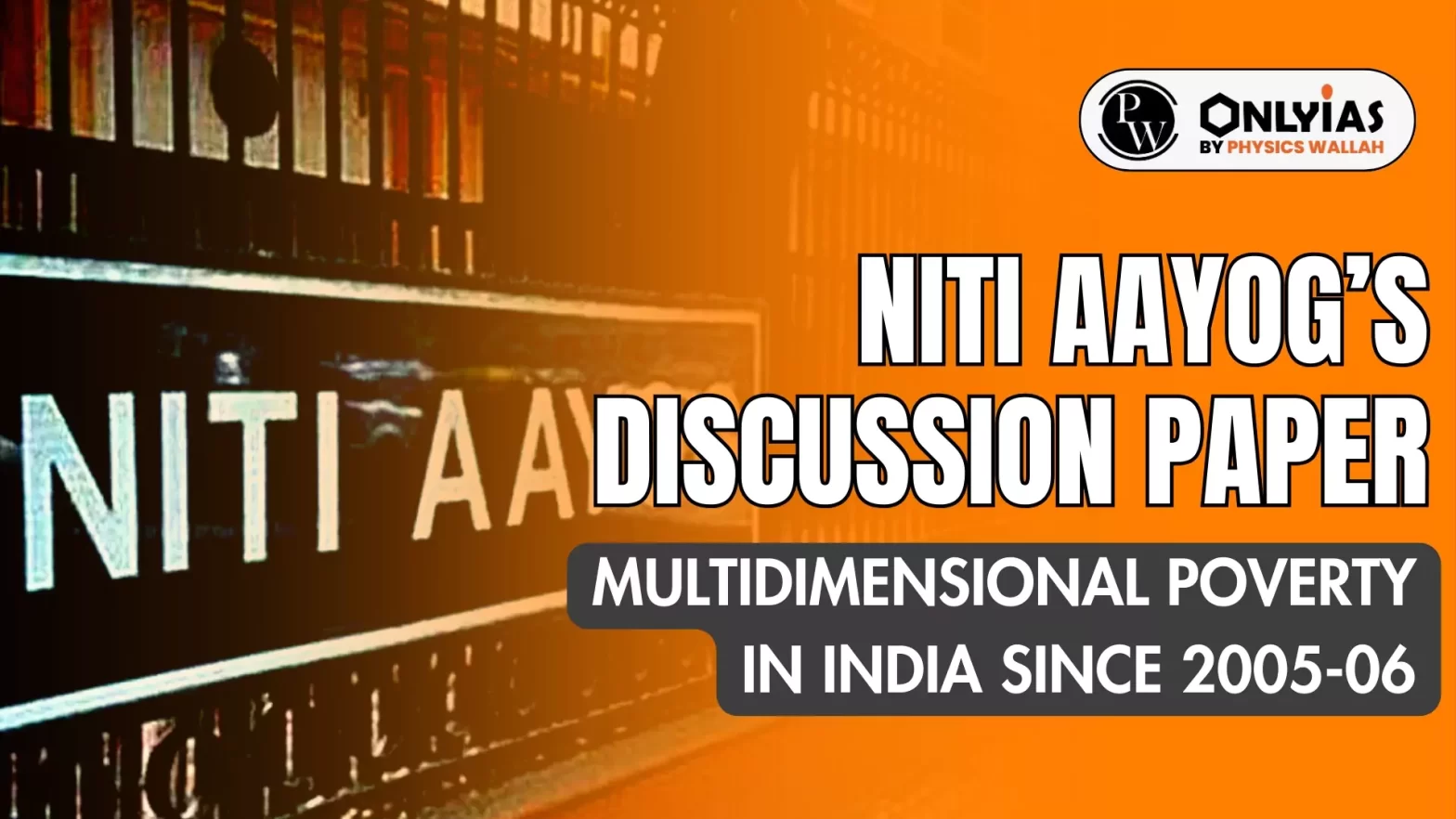
 State-wise Estimates: States like Uttar Pradesh, Bihar, Madhya Pradesh, and Rajasthan recorded the sharpest decline in people classified as poor based on the Multidimensional Poverty Index (MPI).
State-wise Estimates: States like Uttar Pradesh, Bihar, Madhya Pradesh, and Rajasthan recorded the sharpest decline in people classified as poor based on the Multidimensional Poverty Index (MPI).
 Within the standard of living dimension, the highest levels of deprivation in 2005-06 were found in indicators such as Cooking Fuel (74.40%), Sanitation (70.92%), and Bank Accounts (58.11%).
Within the standard of living dimension, the highest levels of deprivation in 2005-06 were found in indicators such as Cooking Fuel (74.40%), Sanitation (70.92%), and Bank Accounts (58.11%).  Global Multidimensional Poverty Index (MPI): It is an international measure of acute multidimensional poverty that complements traditional monetary poverty measures by capturing the acute deprivations in health, education, and living standards that a person faces simultaneously.
Global Multidimensional Poverty Index (MPI): It is an international measure of acute multidimensional poverty that complements traditional monetary poverty measures by capturing the acute deprivations in health, education, and living standards that a person faces simultaneously. Multidimensional Poverty Index (MP) is considered a better measure to estimate poverty than conventional measures.
Multidimensional Poverty Index (MP) is considered a better measure to estimate poverty than conventional measures.